How to start? Isn’t that a question we ask ourselves all the time? It’s always hard to start something new. The older you get, the higher boundaries seem to go and the less flexible we seem to become. Whether it’s learning another language, starting your own business, or in this case, jumping on a surfboard and chase waves. It’s an adventure. Learning to surf isn’t easy, let’s clear that up. It’s a lot of fun though and worth every single wipeout. A great place to start surfing is Bali. But where should you start? And how? What do you need to know? And aren’t you too old to learn? Nope, never. Just keep on reading this Bali surf guide for beginners. I bet I can even convince my mom to get on a surfboard.

Where to start?
Let’s start with the most important question. What would be a Bali surf guide without discussing the best beach in Bali to start learning? I would start in either Batu Bolong (Canggu) or Legian Beach (Kuta). These two beaches have a (semi) beach break, which means that beneath those waves there’s just sand. No rocks or reef that can hurt you when you fall (you will fall off a lot). Both of those beaches have lots of surf rental shops on the beach where you can get a surfboard and surf lessons. I know it’s really tempting to get a shortboard straight away, but believe me, you WANT one of those big ass foam boards. Why? Because of your balance. One of the first things you’ll learn while surfing is how to stand up, and it’s way easier to learn this on a big stable foam board than it is on a shortboard. Safer for you and your surroundings as well, so aim at 8’ feet up to 9‘6. The bigger the better.
How to start learning to surf
It depends a bit on the time you’d like to invest in learning how to surf. If you just wanna give it a try for an afternoon, get a three-hour lesson, preferably private. This way you can really get a taste of it, while actually achieving something with a guide that’s totally focused on you. If you feel like you need more time to properly get the hang of it, book yourself into a surf retreat. I would highly recommend doing this. That way you spend lots of time in the water, you learn a bit more about how to read waves and the ocean, and you can actually see the improvement you’re making in quite a short time. There are plenty of surf camps in Bali, so finding one that suits your needs won’t be a problem.
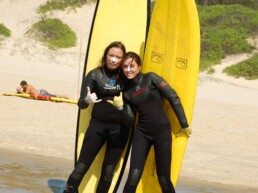
What do you need to know
Before you run into the ocean with a big foamie under your arms, there are a few things handy to consider. Surfing is an extreme sport and nature is ALWAYS stronger than you are. Don’t underestimate this. Then again, don’t let it scare you either, because surfing is seriously one of the best things to do in life.
The power of the ocean
The most important thing to take into account before jumping into that big blue ocean is that actual pool of water. That ocean is a force of nature and it’s good to know that every single beach is different. Make sure you know how the current is, if there are any rips, and what the general conditions are. That way the lifeguards can keep on chilling on the beach, just how we like it. When arriving at a surf spot, make sure to spend at least 30 minutes studying the waves before you paddle out. Watch where the waves break, where other surfers paddle out, how big the sets (the bigger waves coming through) are, and what level of surfers the other people in the water are. Don’t paddle out when the waves look too big or heavy for you.
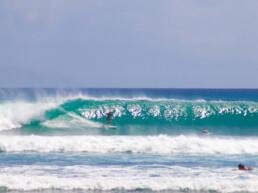
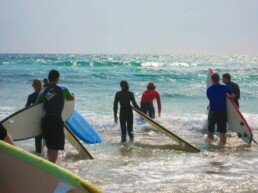
Safety first
Then, important as well, as I notice a lot of beginner surfers tend to forget about this. Hold on to your board! You got a big foamy board that, although made of foam, can do some damage to the people around you. Your teacher will learn you how to get through the waves, so pay good attention here. Don’t just jump off your board or let it slip without looking around if there aren’t any people around you. When trying to get through the waves, always make sure your board is vertically placed, not horizontally. It saves you a broken nose.
Right of way
It’s not only the ocean that brings a set of rules with it, but also the activity itself. There are a few surfing etiquettes that are handy to know once you go surfing green waves. The most important one is to make sure you’re not taking anyone else’s wave. Remember that the surfer closest to the breaking wave has priority. If anyone else is already on the wave, then it’s not yours to take. Have respect for the locals, as they surf those waves every single day and you are visiting their home base.
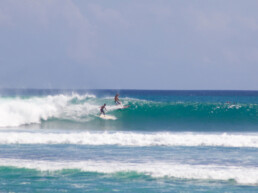

Do a warming up
Believe me when I say that a warming-up is crucial for your happiness. You will be using muscles you never knew existed and with that comes some serious muscle pain. However, warming up will help you minimize this a bit, plus will make it easier for you to paddle out and pop up. Focus on your shoulders, arms, and core while losing up and stretching.
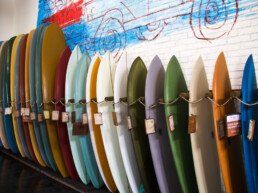
You got addicted. What's next?
I totally get you! Apparently with surfing you either hate it or love it. I remember my first surfing experience where I actually expected to hate it but ended up being dragged out of the water because the sun was really setting and dinner was really ready. I got hooked. That feeling of catching a wave is one of the best in the world, and the paddling does get easier.
If you got addicted the best thing to do next is surf as much as possible. Spend as many hours as you can in the water, practicing, falling off your board, getting wiped out, and reading the waves. If you think of buying your own surfboard I can recommend buying a Longboard or a Mini Malibu. These boards are big and stable enough to get some confidence, and small enough to improve. One of the most made mistakes is that people tend to buy a shortboard too quickly, which leaves them struggling in the water instead of catching loads of waves and learning to become better.
The Bali Surf Guide for beginners Recap
Do you rather look at images than reading stories? No worries, we have a short recap of everything you need to know below.
Best beginner surf beach
Legian Beach or Batu Bolong
Surf essentials
Long sleeve rash guard, sunscreen and block (LOTS), zinc, and patience.
Surf shop
Folklore Surf in Canggu
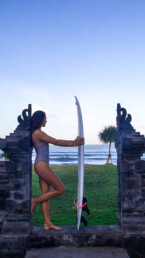
After surf breakfast
Best time to visit
From May till September; it's the dry season and the swells hit the West Coast and Bukit Peninsula.
Water temperature
Between 27ºC or 81ºF in July-September, to 29ºC or 84ºF in November-May.
Just some final words
I hope this Bali surf guide gave you some itchy feet to give surfing a try as well. Those sunrise surfs, the salty hair, the good-looking surf boys and girls, and of course, just being out and active in nature really gets addictive. Maybe some last advice. Have a good sunblock, a proper warm-up (you’ll regret it the rest of the week if you don’t), and lots and lots of fun. Surf’s up!
Love,
Marthe
Ps. The best tip I ever got: PADDLE, PADDLE, PADDLE! The moment the wave touches your feet, give it three more paddles, and GO! Guaranteed success.

Photos by: M. Barends & J. Roeland©
Related Posts
Lodges Ekologika on Portibi Farms: a garden of Eden in Java
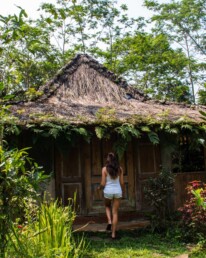
Cimaja: the perfect surf escape in Java
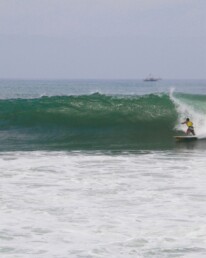
Desa Seni: yoga heaven in Canggu
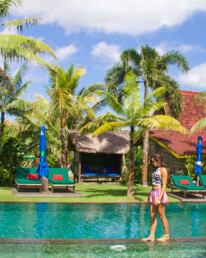


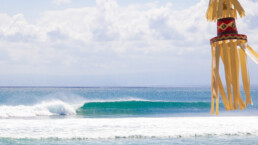
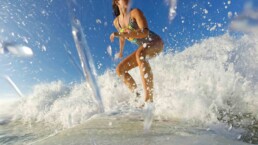
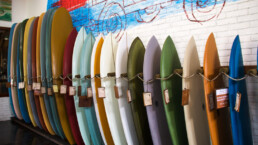



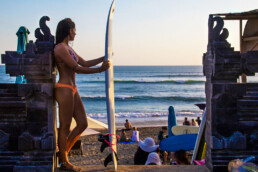
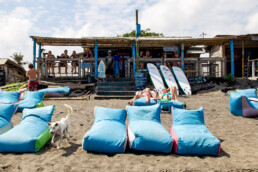

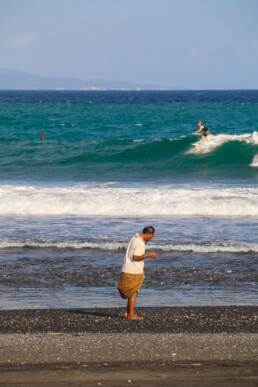
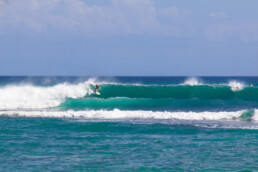
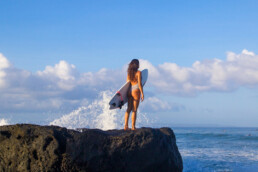
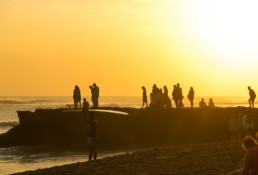



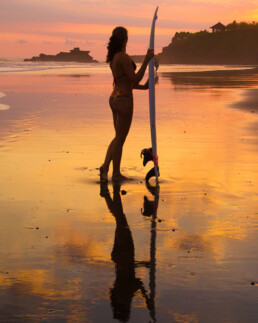
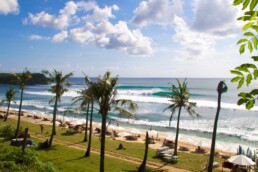
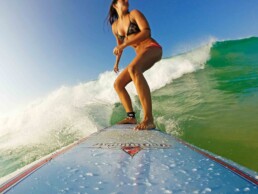
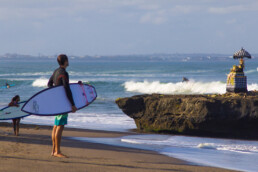
Awesome post! See you in Costa Rica
awesome post
let me know if you are in Bali again and check us out
bgsbali.com for a happy vibes after surfing
Wonderful information, thanks a lot for sharing kind of content with us. Your blog gives the best and the most interesting information. I wonder if we can gather such practical information about Bali surfing guide beginners, a great post definitely to come across.
Thank you for your kind comment!
[…] Other notable spots include Padang Padang & Canggu. Padang Padang features powerful, barreling waves. It’s ideal for intermediate surfers hoping To advance skills. Canggu, with its laid-back atmosphere, attracts a youthful crowd. Vibrant beach clubs mark this area, providing social opportunities between sessions. For more information, visit Bali Surf Guide for Beginners. […]